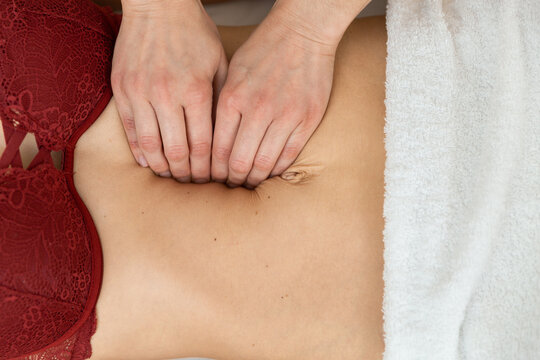Back
What Should I Do About Diastasis Recti?
By Dr. Christine Martirez PT, DPT on 5/17/2024

Diastasis recti is a common condition that affects many individuals, characterized by the separation of the rectus abdominis muscles along the midline connective tissue of the abdomen. This separation can lead to a range of symptoms and aesthetic concerns, but fortunately, pelvic floor physical therapy offers effective strategies for managing and improving this condition. In this blog post, we’ll explore the anatomy involved in diastasis recti, the causes of this condition, including pregnancy and rapid weight gain, and how pelvic floor physical therapy can help in recovery.

Anatomy Involved in Diastasis Recti
Rectus Abdominis:
The rectus abdominis muscles, commonly known as the "six-pack" muscles, run vertically along the front of the abdomen. These muscles are crucial for flexing the spine and stabilizing the core.Linea Alba:
The linea alba is a band of connective tissue that runs down the midline of the abdomen, connecting the left and right sides of the rectus abdominis. It plays a critical role in maintaining the integrity and function of the abdominal wall.Internal and External Obliques:
The internal and external oblique muscles are located on the sides of the abdomen. They work together to rotate the trunk, flex the spine laterally, and support abdominal pressure and stability.Transverse Abdominis:
The transverse abdominis is the deepest layer of abdominal muscles, wrapping around the torso like a corset. It provides essential support for the abdominal organs and helps maintain intra-abdominal pressure.

What is Abdominal Coning?
Abdominal coning, also known as "doming," occurs when there is an increase in intra-abdominal pressure, causing the abdomen to protrude outward in a cone-like shape. This phenomenon is often observed in individuals with diastasis recti when they perform certain movements or exercises that strain the abdominal wall. Coning indicates that the abdominal muscles are not effectively engaging or providing adequate support, leading to the separation and bulging of the linea alba.
Causes of Diastasis Recti
Diastasis recti can occur due to various factors, including:
Pregnancy:
During pregnancy, the growing uterus stretches the abdominal muscles and connective tissue to accommodate the developing baby. The hormonal changes, particularly the increase in relaxin, soften the connective tissues, making them more susceptible to separation. This separation can persist postpartum, leading to diastasis recti.Rapid Weight Gain:
Rapid weight gain, whether due to lifestyle factors or medical conditions, can put excessive pressure on the abdominal wall. This pressure can stretch and weaken the connective tissue of the linea alba, resulting in diastasis recti.Improper Exercise Techniques:
Engaging in exercises that place excessive strain on the abdominal muscles, especially without proper form and core engagement, can contribute to the development of diastasis recti. This is particularly common in weightlifting and other high-intensity activities.
How Pelvic Floor Physical Therapy Can Help
Pelvic floor physical therapy offers a comprehensive approach to managing diastasis recti by addressing the underlying muscle dysfunction and promoting optimal recovery. Here’s how it can help:
Muscle Assessment and Education:
A pelvic floor physical therapist will assess the severity of diastasis recti and evaluate the function of the abdominal and pelvic floor muscles. They provide education on the condition and its impact on the body.Core Strengthening Exercises:
Targeted exercises that focus on the transverse abdominis and other core muscles can help restore strength and stability to the abdominal wall. These exercises are designed to engage the deep core muscles without straining the linea alba.Postural Training:
Improving posture can significantly reduce the pressure on the abdominal wall. A pelvic floor physical therapist will teach proper body mechanics and alignment to support the core muscles.Breathing Techniques:
Learning proper breathing techniques, such as diaphragmatic breathing, can help manage intra-abdominal pressure and prevent further separation of the abdominal muscles.Manual Therapy:
Hands-on techniques, such as myofascial release and soft tissue mobilization, can help improve the flexibility and function of the abdominal muscles and connective tissue.Lifestyle Modifications:
The therapist will provide guidance on modifying daily activities and exercise routines to avoid movements that exacerbate diastasis recti. This may include advice on lifting techniques, safe exercise practices, and ergonomic adjustments.
Diastasis recti is a common condition that can affect both women and men, particularly during pregnancy or periods of rapid weight gain. Understanding the anatomy involved and the causes of this condition is crucial for effective management and recovery. Pelvic floor physical therapy offers a holistic approach to treating diastasis recti, focusing on strengthening the core muscles, improving posture, and providing education on safe practices. By working with a skilled pelvic floor physical therapist, individuals with diastasis recti can achieve better function, reduced symptoms, and improved overall well-being.
Dealing with diastasis recti or other pelvic floor issues? Reach out to us at Pelvic Health Center in Madison, NJ to set up an evaluation and treatment! Feel free to call us at 908-443-9880 or email us at receptionmadison@pelvichealthnj.com.
Read More:
Dry Needling for C-Section Scars and Postpartum Recovery By Dr. Christine Martirez PT, DPT on 10/15/2024 Learn how dry needling can be used for c-section scars and c-section recovery How Red Light Therapy Can Be Used to Treat Pelvic Floor Dysfunctions By Dr. Christine Martirez PT, DPT on 10/15/2024 Learn about red light therapy and how it can be used to treat pelvic floor dysfunctions
Are you ready to live pain free?
Request An Appointment